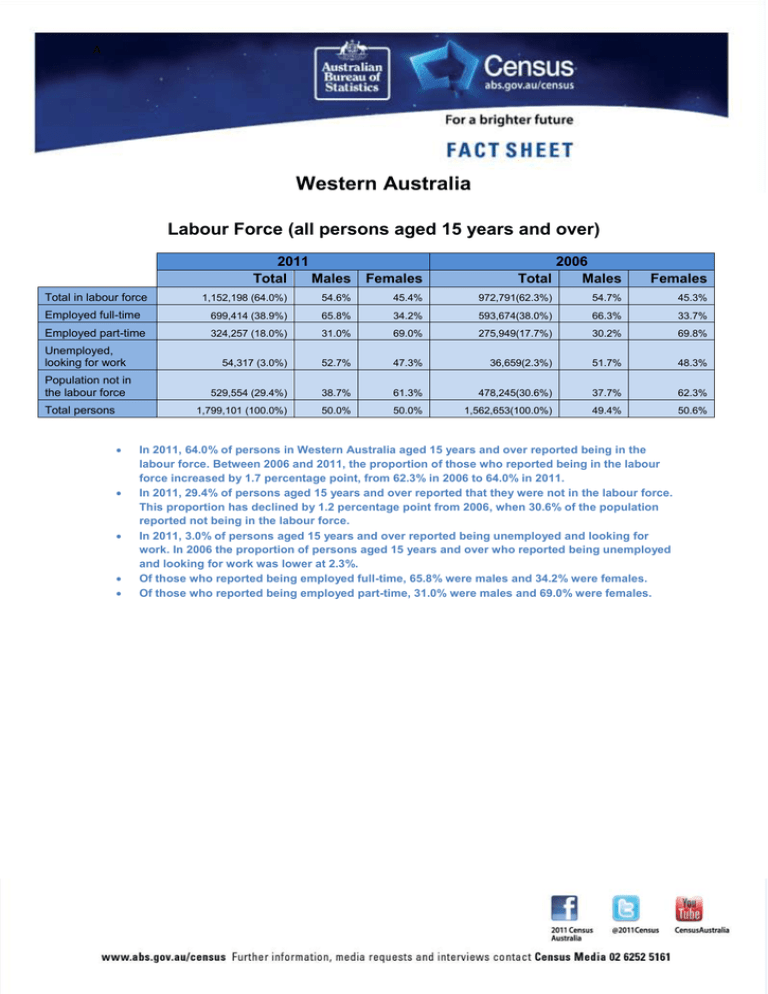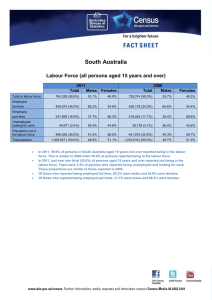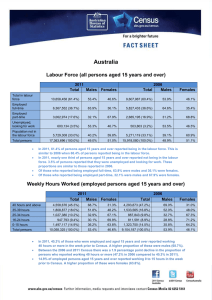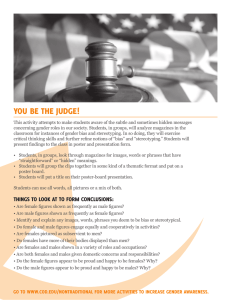Western Australia Labour Force (all persons aged 15 years and over) A
advertisement

A Western Australia Labour Force (all persons aged 15 years and over) 2011 Total Males Total in labour force Females Total 2006 Males Females 1,152,198 (64.0%) 54.6% 45.4% 972,791(62.3%) 54.7% 45.3% Employed full-time 699,414 (38.9%) 65.8% 34.2% 593,674(38.0%) 66.3% 33.7% Employed part-time 324,257 (18.0%) 31.0% 69.0% 275,949(17.7%) 30.2% 69.8% 54,317 (3.0%) 52.7% 47.3% 36,659(2.3%) 51.7% 48.3% 529,554 (29.4%) 38.7% 61.3% 478,245(30.6%) 37.7% 62.3% 1,799,101 (100.0%) 50.0% 50.0% 1,562,653(100.0%) 49.4% 50.6% Unemployed, looking for work Population not in the labour force Total persons In 2011, 64.0% of persons in Western Australia aged 15 years and over reported being in the labour force. Between 2006 and 2011, the proportion of those who reported being in the labour force increased by 1.7 percentage point, from 62.3% in 2006 to 64.0% in 2011. In 2011, 29.4% of persons aged 15 years and over reported that they were not in the labour force. This proportion has declined by 1.2 percentage point from 2006, when 30.6% of the population reported not being in the labour force. In 2011, 3.0% of persons aged 15 years and over reported being unemployed and looking for work. In 2006 the proportion of persons aged 15 years and over who reported being unemployed and looking for work was lower at 2.3%. Of those who reported being employed full-time, 65.8% were males and 34.2% were females. Of those who reported being employed part-time, 31.0% were males and 69.0% were females. A Western Australia Weekly Hours Worked (employed persons aged 15 years and over) 2011 2006 Total Males Females Total Males Females 40 hours and above 526,184(47.9%) 71.3% 28.7% 453,715(48.5%) 71.6% 28.4% 35-39 hours 173,233(15.8%) 49.0% 51.0% 139,957(15.0%) 49.0% 51.0% 25-34 hours 104,597(9.5%) 31.3% 68.7% 88,914(9.5%) 31.6% 68.4% 16-24 hours 100,864(9.2%) 29.8% 70.2% 82,958(8.9%) 28.1% 71.9% 0-15 hours 170,538(15.5%) 37.5% 62.5% 144,080(15.4%) 36.4% 63.6% 1,097,879(100.0%) 54.7% 45.3% 936,130(100.0%) 54.9% 45.1% Total persons In 2011, 47.9% of persons who were employed and aged 15 years and over in Western Australia reported working 40 hours or more in the week prior to the Census. A higher proportion of these were males (71.3%). Between the 2006 and 2011 Censuses there was a slight decline (0.6 percentage point) in the proportion of persons who reported working 40 hours or more (from 48.5% in 2006 to 47.9% in 2011). Of all employed persons aged 15 years and over, 15.5% reported working 0 to 15 hours in the week prior to the 2011 Census. A higher proportion of these were females (62.5%). A Western Australia Top five industries in 2011 (employed persons aged 15 years and over) Health Care and Social Assistance Construction Retail Trade Manufacturing Education and Training Total persons Total 2011 Males Females Total 2006 Males Females 113,773(10.4%) 111,845(10.2%) 110,721(10.1%) 90,392(8.2%) 88,077(8.0%) 1,097,879(100.0%) 19.7% 85.2% 39.7% 76.8% 27.7% 54.7% 80.3% 14.8% 60.3% 23.2% 72.3% 45.3% 95,160(10.2%) 85,124(9.1%) 104,300(11.1%) 88,409(9.4%) 71,876(7.7%) 936,130(100.0%) 21.0% 85.5% 40.9% 76.8% 29.1% 54.9% 79.0% 14.5% 59.1% 23.2% 70.9% 45.1% In 2011, the largest proportion of employed persons aged 15 years and over reported working in the Health Care and Social Assistance industry (10.4%) followed by the Construction industry (10.2%). In 2006, the Retail Trade industry was the most reported response for employed persons aged 15 years and over (11.1%). The proportion of those who reported being employed in this industry declined to 10.1% in 2011, however there has been a minor increase in the number of persons employed in this industry (6,421 persons). The proportion of employed persons aged 15 years and over who reported Manufacturing as their industry of employment has declined from 9.4% in 2006 to 8.2% in 2011; however, there has been a slight increase in the number of persons who reported being employed in this industry (from 88,409 in 2006 to 90,392 in 2011). In 2011, of those who reported working in the Construction and Manufacturing industry, a higher proportion were males (85.2% and 76.8% respectively). In 2011, of those who reported working in the industries of Health Care and Social Assistance, Education and Training, and Retail Trade, a higher proportion were females (80.3%, 72.3% and 60.3% respectively). A Western Australia Top five Occupations in 2011 (employed persons aged 15 years and over) 2011 Total Males Professionals Technicians and Trades Workers Clerical and Administrative Workers Managers Labourers Total persons Females Total 2006 Males Females 218,354(19.9%) 47.4% 52.6% 173,957(18.6%) 48.1% 51.9% 183,300(16.7%) 85.8% 14.2% 153,563(16.4%) 85.6% 14.4% 158,181(14.4%) 133,801(12.2%) 106,227(9.7%) 1,097,879(100.0%) 21.7% 66.2% 64.4% 54.7% 78.3% 33.8% 35.6% 45.3% 135,975(14.5%) 117,032(12.5%) 102,023(10.9%) 936,130(100.0%) 21.6% 66.6% 63.7% 54.9% 78.4% 33.4% 36.3% 45.1% In 2011, 19.9% of employed persons aged 15 years and over in Western Australia reported working as Professionals. Of those who reported working as Professionals, 52.6% were females. The proportion of those who reported working as Professionals has increased by 1.3 percentage point from 18.6% in 2006 to 19.9% in 2011. The number of persons who reported working as Technicians and Trade Workers increased from 153,563 (16.4%) in 2006 to 183,300 (16.7%) in 2011. The proportion of those who reported working as Clerical and Administrative Workers decreased from 14.5% in 2006 to 14.4% in 2011, but there was an increase in the number of persons who reported working in this profession (from 135,975 in 2006 to 158,181 in 2011). The proportion of those who reported working as Labourers declined (by 1.2 percentage point from 10.9% in 2006 to 9.7% in 2011) but the number of persons who reported working in this profession increased by 4,204 persons. Of those who reported working as Technicians and Trades Workers (16.7%), a higher proportion were males (85.8%). This compared to 14.4% of persons reporting as Clerical and Administrative workers, of whom 78.3% were females. A Western Australia Highest Level of Education (all persons aged 15 years and over) 2011 Total Males Postgraduate Degree Graduate Diploma and Graduate Certificate Females Total 2006 Males 31,669(2.0%) 59.3% 40.7% 51,628(2.9%) 56.0% 44.0% Females 29,483(1.6%) 36.3% 63.7% 20,698(1.3%) 36.8% 63.2% 234,399(13.0%) 44.3% 55.7% 173,245(11.1%) 45.2% 54.8% 146,283(8.1%) 42.9% 57.1% 116,162(7.4%) 42.7% 57.3% Certificate III/IV 299,823(16.7%) 71.9% 28.1% 230,621(14.8%) 74.9% 25.1% Year 12 311,821(17.3%) 46.2% 53.8% 263,066(16.8%) 46.2% 53.8% 495,079(27.5%) 43.7% 56.3% 488,470(31.3%) 42.8% 57.2% 1,799,701(100.0%) 50.0% 50.0% 1,562,653(100.0%) 49.4% 50.6% Bachelor Degree Advanced Diploma and Diploma Year 11 or below (includes Certificate I/II/nfd) Total persons nfd: not further defined In 2011, there was a significant increase in the number of persons aged 15 years and over in Western Australia who reported completing a Postgraduate Degree, from 31,669 in 2006 to 51,628 in 2011 (a 63.0% increase). There has also been a significant increase in the number of persons who reported completing a Graduate Diploma or Graduate Certificate as their highest level of education, from 20,698 in 2006 to 29,483 in 2011 (an increase of 42.4%). There was a significant increase in persons who reported completing a Bachelor Degree as their highest level of education, from 173,245 in 2006 to 234,399 in 2011 (an increase of 35.3%). There has been a slight increase in the number of persons who reported Year 11 and below (including Certificate level I/II) as their highest level of education, from 488,470 in 2006 to 495,079 in 2011. A higher proportion of those who reported their highest level of education as Graduate Diploma or Graduate Certificate, Bachelor Degree, and Advanced Diploma and Diploma were females (63.7%, 55.7% and 57.1% respectively). Of those who reported completing Certificate III/IV as their highest level of education a higher proportion were males (71.9%). A Western Australia Top five Fields of Study in 2011 (all persons aged 15 years and over who stated a completed qualification) Engineering and Related Technologies Management and Commerce Society and Culture Health Education Total persons Total 2011 Males Females Total 2006 Males Females 189,627(18.6%) 94.1% 5.9% 152,071(18.3%) 94.3% 5.7% 163,809(16.1%) 91,832(9.0%) 91,391(9.0%) 76,868(7.5%) 1,020,181(100.0%) 38.9% 30.9% 21.9% 21.7% 53.5% 61.1% 69.1% 78.1% 78.3% 46.5% 123,249(14.8%) 68,028(8.2%) 70,690(8.5%) 62,699(7.5%) 831,622(100.0%) 38.8% 32.5% 20.8% 23.6% 53.6% 61.2% 67.5% 79.2% 76.4% 46.4% In 2011, Engineering and Related Technologies (18.6%) and Management and Commerce (16.1%) were the two most common fields of study completed reported by persons aged 15 years and over in Western Australia. These fields were also reported as the most common fields of study in the 2006 Census. Between the 2006 and 2011 Censuses there has been an increase in the number of persons who reported Engineering and Related Technologies (from 152,071 in 2006 to 189,627 in 2011) and Management and Commerce (from 123,249 in 2006 to 163,809 in 2011) as their field of study. Of those who reported Management and Commerce as their field of study, a higher proportion were females (61.1%). Of those who reported Engineering and Related Technologies as their field of study a significantly higher proportion were males (94.1%). More than three quarters of those who reported Health and Education as their fields of study were females (78.1% and 78.3% respectively). A Western Australia Top five Methods of Travel to Work in 2011 (employed persons aged 15 years and over) Car, as driver Car, as passenger Bus Walked only Train Total persons 2011 Total Persons 2006 Total Persons 662,947(60.4%) 63,483(5.8%) 40,761(3.7%) 35,995(3.3%) 24,269(2.2%) 1,097,879(100.0%) 570,271(60.9%) 58,751(6.3%) 32,619(3.5%) 31,758(3.4%) 14,119(1.5%) 936,130(100.0%) Transport by car continues to be the most commonly reported method of travel to work in Western Australia. Almost two thirds (66.2%) of employed persons aged 15 years and over reported that they travelled to work by car (either as driver or a passenger) on 9 August 2011. The number of persons who travelled by bus to work has increased from 32,619 (3.5%) in 2006 to 40,761 (3.7%) in 2011. The number of those who travelled to work by train also increased from 14,119 (1.5%) in 2006 to 24,269 (2.2%) in 2011. The number of those who walked to work has increased slightly from 31,758 in 2006 to 35,995 in 2011; however the proportion of persons who walked to work has decreased slightly (from 3.4% in 2006 to 3.3 % in 2011). A Western Australia Place of Usual Residence one year ago (all persons who moved, excluding persons aged under one year) 2011 2006 286,942 (77.7%) 291,298 (81.4%) Interstate 32,773 (8.9%) 26,784 (7.5%) Overseas 45,825 (12.4%) 36,290 (10.1%) 369,199 (100.0%) 357,737 (100.0%) Within State Total persons Of the WA residents who moved in the year prior to the 2011 Census, most moved within the State (77.7%). There were 45,825 (12.4%) of persons who had moved to WA from overseas in the year prior to the 2011 Census. Place of Usual Residence five years ago (all persons who moved, excluding persons aged under five years) 2011 2006 619,339 (69.8%) 638,781 (78.5%) Interstate 79,727 (9.0%) 64,364 (7.9%) Overseas 179,450 (20.2%) 101,091 (12.4%) 887,428 (100.0%) 813,959 (100.0%) Within State Total persons More than two-thirds (69.8%) of the WA residents who moved in the five years prior to the 2011 Census moved within the state. There were 179,451 (20.2%) of persons who had moved to WA from overseas in the five years prior to the 2011 Census.






